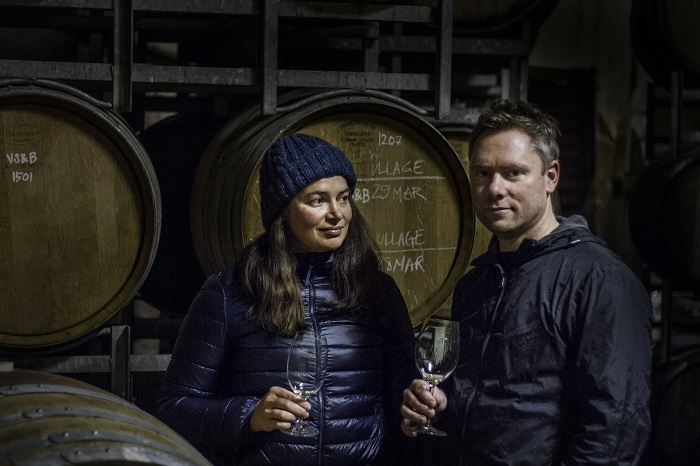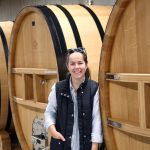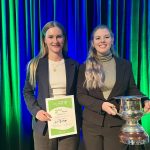A dynamic duo
With a clear sense of where they’d like their wine business to lead, Victorian couple Tessa Brown and Jeremy Schmölzer have embraced a ‘holistic’ approach to developing their vines and winemaking. Journalist Eleanor Danenberg spoke to the pair to learn more about what brought them to their idyllic locale near Beechworth.
No, you’re not seeing double. For the first time in Grapegrower & Winemaker history, we have a young gun team: partners in life and business Jeremy Schmölzer and Tessa Brown make up Vignerons Schmölzer & Brown. Schmölzer is an architect by trade and Brown is a winemaker and viticulturist. Six years ago they left the Melbourne city life behind to buy a bare paddock in the highest altitudes of Beechworth and now they are in the process of constructing their home, winery, vineyard and farm on the same site. The knowledge and passion of the pair is impressive and their future looks bright.
So how did Jeremy and Tessa become Vignerons Schmölzer & Brown? Brown grew up on a sugarcane farm in far north Queensland and science was her best subject throughout school. Just weeks before Brown made her university preferences, she and her family were on holiday in Victoria and had a day trip to Rutherglen.
“Dad had always been a super keen wine drinker, so there was always wine around when I was a kid”.
The visit’s timing proved fortuitous.
“I thought, ‘this viticulture thing sounds interesting’; it’s agriculture with a point of difference. I was interested to go and do something completely different anyway”, Brown reflects.
She studied viticulture at Charles Sturt University in Wagga Wagga, “and the rest is kind of history”.
Brown ventured into the workforce before she went back to university to do her graduate diploma in winemaking at the University of Adelaide. Under Tessa’s belt are viticulture positions at Charles Sturt University and an investment vineyard in Orange, vintages in Spain, Central Otago, Barolo and South Australia (including Shaw + Smith and Wolf Blass), and five years as winery manager/winemaker at Kooyong.
For Schmölzer, this is his first job in wine, starting with the launch of the business in 2014 and a fact-finding Riesling vintage in Rhinehessen in 2015. It may sound like baptism by fire, but he wouldn’t have it any other way: “I got into it by doing”.
Schmölzer had been living and working as an architect in Austria and London, and had recently returned to Australia when he met Brown. He learned about wine “by osmosis, by being around it”. The couple lived in Melbourne for six years and during this time they made friends in the wine trade, and attended tastings and events. Schmölzer immediately loved the culture of the industry.
From the beginning it was a “pipe dream” for the couple to have a farm and vineyard, but it became more serious when they started saving money “for a future that we might not have necessarily had all written down, but the idea never went away”. A high altitude property 11kms outside of Beechworth came on the market and they made the decision to jump.
“You think buying a house or a block of land would be so terrifying, but the thing we both remember [from that time], it was so calm,” Brown reflects.
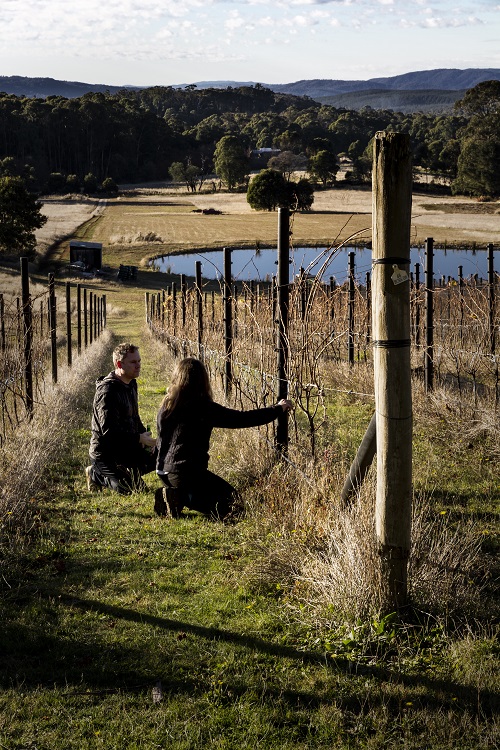
Thorley and Brunnen vineyards
The 2ha Thorley vineyard is on their 20ha property and just across the road is the 0.7ha Brunnen vineyard, which the couple run with their neighbour who owns the land. Brown and her mother do most of the vine work together with casual assistance at pruning, shoot thinning and vintage. Schmölzer takes the tasks that can be timed around his day job, including record-keeping and weather sequencing/planning, with both he and Brown handling sales together. In the early days of Vignerons Schmölzer & Brown, everybody pitched in for picking days, including family and friends.
“As we’ve got a little bit more volume and size, we’ve been able to get help in the vineyard and winery. Both of us have been able to step back and look at how we’re running things,” Schmölzer says.
I put it to the couple that they complement each other well.
“That would be one way to put it,” laughs Schmölzer. “Sometimes we nag each other a bit too, but for the most part I’m very grateful for Jeremy’s Germanic organisational skills,” Brown adds.
While “the wines still need to stand up for themselves”, Schmölzer is grateful Brown is “really engaging” and that her pre-established contacts, knowledge and support in the industry aided the business in its early days; “You hear about people who don’t have that and it’s a struggle for them to get seen [as] it’s a big industry with so many options”.
While any new business is a struggle, they focus on the positives.
“You get rewarded when you see things like our vineyard plants growing; a physical manifestation of all that work,” Schmölzer says. “It’s only a young vineyard, but tasting the fruit gets us really excited. All that helps to balance against the times when it’s a struggle, because it’s a lot of hard work.”
The Thorley vineyard was only planted five years ago and isn’t in full crop yet; but according to Schmölzer the vines are “looking really solid, excellent quality for the age. [They’re] enough to make wine with it and to see the quality”.
Brown adds that the Shiraz is building up.
“It’s probably half the crop that it will be, and we’re starting to get a trickle of Chardonnay, Riesling, and Nebbiolo”.
At the same time, the duo are making wines from established vineyards including Brunnen, where Vignerons Schmölzer & Brown’s Pinot Noir and Chardonnay is sourced from.
“[The site has] shown the promise of hopefully what’s coming on our site, as it’s one of the only vineyards in this area at that altitude,” Brown says, adding that they’re excited to have more fruit coming from Thorley: “To see what it can do, what it wants to taste like; how to make the wine respectfully so it looks like where it comes from”.
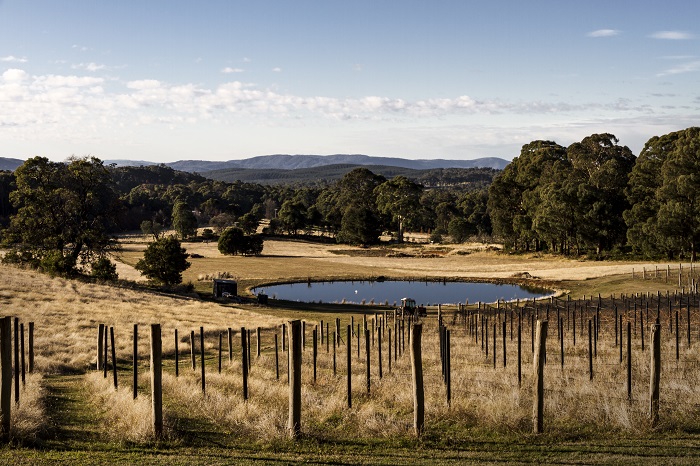
Growing into something magical
The plan is for the Thorley and Brunnen grapes to be grown organically, with certification on the cards in the next few years when finances allow a transition to undervine cultivation. The site won’t just be a vineyard either as it will become a “holistic farming exercise”.
“We’ll have animals to control the grass and provide manure, to fertilise the vineyard in the winter; and we’ve got English oaks planted, inoculated with truffles, to supplement our income,” Brown outlines.
She says there’s also a dam of spring water.
“Down the track, ideally, you’ll see a mixed bag of things happening on the property, all working with and assisting each other in how each aspect of the farm interacts”.
There are also plans for the periphery of the farm to be lined with a fire-resistant windbreak of trees such as oak, maple, birch, chestnut, walnut, and more. Brown happily dedicates her limited free time to propagating trees; their backyard is a mini-nursery with “dozens if not hundreds of trees” prepared for the site.
“I love growing plants and I’m lucky enough to grow 10,000 of them for a living,” Brown adds, clearly hands on at every stage of the business.
“It was a bare paddock when we got to it, [and] it’s slowly growing into something quite magical,” Schmölzer confirms.
Schmölzer, Brown, and their two-and-a half year old daughter Remi are currently living in a rental property in Beechworth while their new home and winery are under construction.
“An architect never has time to build their own house,” Schmölzer advises sagely.
For now their winery is an old apple shed with a cool room, but their costeffective new winery and house will be one building. It’s “currently some lovely images on a computer”, with plans to ideally get started later this year “to get the winery set up for the 2021 vintage”.
“I’m still tweaking the design and making fundamental changes and improving as we learn,” Schmölzer says.
For now, the site has unofficially become the camping spot for the extended family and while her parents are making wine, Remi runs around and plays in the mud; “it’s got a really good atmosphere, she’s really lucky to have that chance to grow up with it”.
Even though Remi is young, invariably in the wine industry talk turns to the younger generations taking over their families’ businesses. Schmölzer and Brown are “equally open to her doing that and working towards that if that’s what she wants to do; and if she chooses another path, we’ve got to let her be herself”, adding they’d encourage Remi to do what they did: “go out and see the world, make your choices as late as possible, [and] keep an open mind”. Schmölzer points out, “the house she’ll grow up in will have a winery out the back, so she won’t be able to avoid learning a lot about it. She can see the struggles of running your own business, meaning you’re working all the time – but equally she’ll see you can create your own day, your own path”.
Brown’s favourite thing about her work is “just observing the pattern of things and being in it”. Her favourite vine job is still pruning, with “something meditative about the repetition. There’s something good for the soul about being out in the paddock in the cold, listening to the winter birds make their sounds in the surrounding forest. Observing the seasons and seeing what each growing season will bring, and being a part of it but not being in control of it”.
For Schmölzer, the diversity of the work is his favourite part of the job: “it’s fun to travel and meet sommeliers in restaurants and talk wine and eat great food; it’s equally amazing to be out in the ice cold in the middle of winter on the farm, or spending the day on the tractor. What we do for work means we never are in a repetitive circumstance from day to day and week to week, everything always changes. [To] spend time in the elements, in nature, really depending on it, [and] watching the rain come with excitement because it’s part of our business: that’s entirely what was so attractive from the very outset, even though I didn’t know much about what I was getting into”.
For Schmölzer and Brown, it’s more than a financially and environmentally sustainable farm with wine as the focus; it’s the prospect that they are working toward something beyond them that is the most magical part of all. “It would be pretty amazing to have done the right thing: if what gets left there is better than what we arrived at.”
This article was originally published in the June issue of Grapegrower & Winemaker magazine. To subscribe, click here.
Photos by Melany Wimpee.
